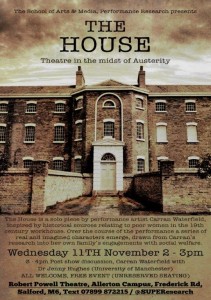Carran’s Working Diary 21: Overwhelmed
We went to Salford with the concert and it was really good. Great questions and great responses to the concert and the pre concert unpacking.
Now I am working through more information from the Data Protector that leaves me with so so many other questions.
Nana was “in hospital” for so much longer than I thought. Going back to 1916 when she was 17 she was in St Audry’s, Melton, Suffolk for two years and then back there again until 1927. Out for seven years and then in St Mary’s Tattingstone until 1947 and then out for three months and then back again until going to Beech House, Halesworth in the late sixties. I can’t equate this with the Nana I knew through many letters and parcels and one personal encounter in the late 60s/early 70s. The image is dim. The site of the memory is church, bedroom and photograph album all mixed up with Ken Dodd or some other famous performer who went to Beech House maybe Roy Hudd or someone like that.
I have to say the data protector’s charges are very expensive but I suppose family history is a local government earner and so considering the cuts it is a way of generating income but it’s odd to have to pay so much to unravel your grandma’s story. I will tell you the total when it’s over if it ever will be. There is a thing called archive fever which I know too well…it is a driver to the past and it is insatiable.
How does all this link creatively and mythically? Well St Audry’s was a workhouse then became an asylum and then dropped the uncomfortable connotations and became a psychiatric hospital. More interestingly who was St Audry/Audrey? Well here she is St Audrey. Thank you wikipedia – the shortcut research engine. If you are interested in reading about 19th century mental health care, “The Handbook for the Instruction of the Care of the Insane” is a good source. This was recommended to me by Christine Selim who worked for the Rochdale Health Authority in the 90s and trained in Bromsgrove. The handbook reminds me of the book I use in The House: The Handy Book for the Guardians (not the matrons) the Guardians of the Poor by George C. T. Bartley. “It’s a good book. It tells you about decisions that are made higher up. It tells you about the compartmentalisation of everyone. It tells you how to check if someone is really a vagrant or if someone is really sick or if someone is really a wh wh wh whore….and so on..etc etc etc……
Next stop Beetham, Cumbria – whose workhouse was in Milnthorpe. This is a really stimulating journey. Matron’s back story comes partly from Milnthorpe.


Comments are closed
Sorry, but you cannot leave a comment for this post.